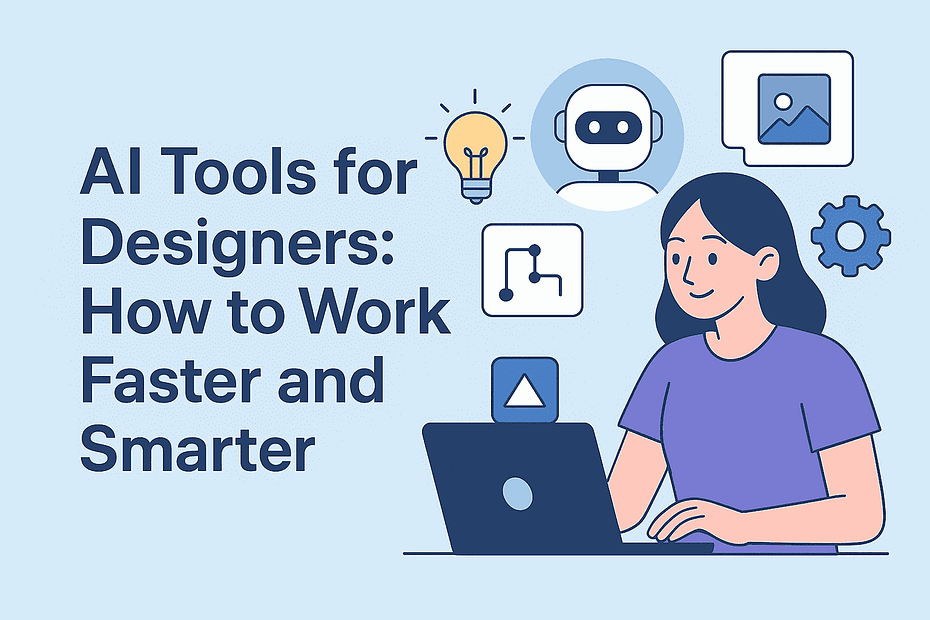How AI Tools Are Changing the Way We Design
Design has been used for creativity, communication, and problem-solving, but in recent years, one thing has changed through AI (Artificial Intelligence), which is known as AI Tools. It is fast, accessible, easy to use, and surprisingly smart, and it can do work in minutes that once took many hours. By AI, we can do any work in minutes, whether you are a professional designer or a beginner designer trying to make a social media template, or a company clerk who wants to create Excel data. AI can save your effort and time both, and also provide good results.
In this blog, we will talk about how you can use AI tools to work more efficiently and create quick designs. We’ll also look at the types of tools available and share tips that can help you in your work.
AI tools aren’t here to replace your creativity—they’re here to support it. Think about when you’re stuck with a white empty canvas, caught in the middle of a design, or when a deadline is near—AI tools can help you in those moments.
- Suggest color combinations that work together
- Create templates, layouts, or even entire social media posts
- Quickly edit or enhance photos
- Produce mockups and presentations for clients
Instead of starting from scratch, you get a strong base to build on. That means you don’t have to spend so much time on designs, and you get more time to refine your work.
Types of AI Tools for Quick Designs

AI design tools come in different ways depending on what you need. Here are some of the most useful AI tool categories:
1. AI Image Generators
When you need visuals quickly, these tools create images based on text prompts. You just write how the image should look, and AI turns your words into images. Great for concept art, brainstorming, or placeholders.
Examples: Adobe Firefly, Midjourney, DALL·E, Leonardo AI, Stable Diffusion
2. AI Graphic and Template Tools
For ready-to-use designs, these AI tools help with social media posts, flyers, presentations, and more.
Examples: Canva AI, Fotor, VistaCreate, Freepik AI, Adobe Express
3. AI Color and Font Helpers
When choosing the right colors and fonts feels confusing, AI tools can suggest professional combinations.
Examples: Khroma (color palettes), Fontjoy (font pairing)
4. AI Background Removers and Editors
If you need to remove or fix a background fast, these tools make it simple and efficient.
Examples: Remove.bg, Cleanup.pictures
5. AI Logo and Branding Tools
When you want logo ideas or a quick brand kit, these tools can give simple but usable designs in minutes.
Examples: Looka, BrandCrowd
How to Get the Best Results
AI can do many things, but your input decides the output. Here are some practical tips:
Use clear prompts: The more specific and clear you write, the better the outcome. Instead of “poster design,” try “minimalist poster design with pastel colors and bold typography.”
Mix AI with human creativity: If the generated result doesn’t match your vision or brand, rewrite the input and adjust until it does.
Experiment with multiple tools: One tool might generate images, another remove backgrounds, some suggest colors, and others help with layouts. Combining them often gives the best results.
Focus on quality control: Sometimes AI can produce generic or inaccurate designs. Double-check fonts, alignment, and readability.
Stay ethical: Avoid delivering raw AI output to clients without your creative input. This keeps the work authentic.
Practical Examples of Quick AI Design Tasks
Here are some scenarios where AI tools can save your time:
- Social Media Post: Instead of creating one from scratch, you can use Canva’s AI to generate a ready-made template, presentation, or poster, then adjust colors and text in minutes—much faster than building everything manually.
- Client Presentation: Need a mood board quickly? Use Khroma to create a color palette and Midjourney, Stable Diffusion to generate sample images, saving you hours of searching and collecting references.
- E-commerce: Selling products online and want to remove backgrounds fast? Use Remove.bg to instantly clear backgrounds and make your images look professional, without spending time on detailed editing. In my experience, Remove.bg saves hours.
- Logo Drafting: Use Looka to generate multiple logo variations, and then modify them according to your needs. This gives you instant starting points instead of sketching every option from zero.
Balancing Speed with Creativity
AI can speed up your workflow and inspire, but speed isn’t everything. What makes your work valuable is your personal vision and the skill to connect with people through your design. Think of AI as your assistant—it helps with the heavy lifting, but don’t just accept what the AI tool creates. Add your design knowledge, because the final design should always carry your unique touch.
For example, AI might suggest a trendy color palette, but it’s up to you to modify it to match your client’s requirements. Or it might generate a layout, but you decide where the focus should be. This balance ensures that your work is quick, yet still authentic.
The Future of AI in Design
AI tools are improving rapidly, and they’re becoming an integral part of the normal workflow for many designers. Instead of fearing replacement, it’s better to embrace them as partners or assistants. Designers who learn how to use AI smartly will be able to work faster, save time, handle more projects, and still keep creativity at the core of their work.
If you’re just starting out, try experimenting with free AI tools and build your confidence. Over time, you’ll figure out which tools fit best into your workflow. Remember—AI is just a tool. The real value comes from how you, as a designer, use it.
So the next time you’re short on time, don’t stress. Let AI tools handle the basics, and put your focus where it matters most: creativity, storytelling, and originality.
